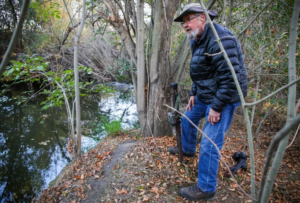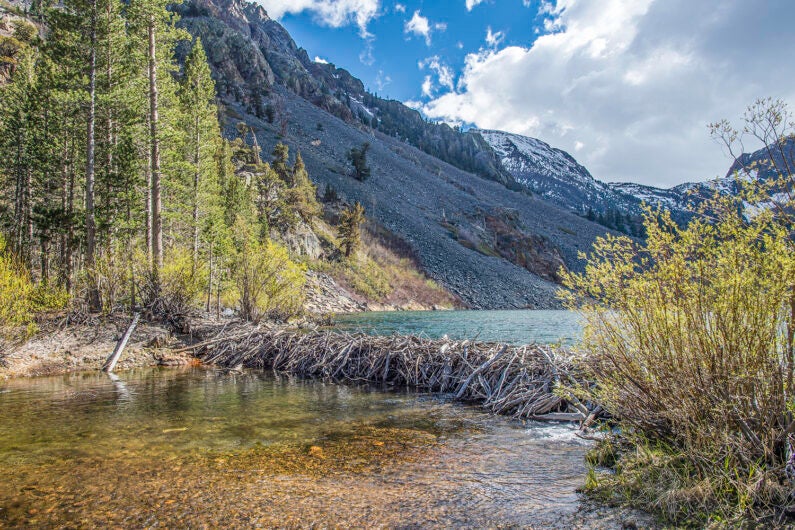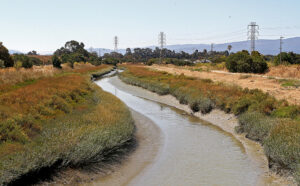Well the fine article I was expecting from my chat with Lisa Kreiger finally dropped yesterday at 8 am so I couldn’t review it that morning which is fine. It gave me an entire day to wrap my head around why she ever felt she needed to soften her good news with words like “smelly” and “eat their own poop”. School yard taunts I guess to keep her from being called a beaver sissy?
Plump, smelly and paddle-tailed, this important rodent is making a comeback in San Francisco Bay creeks
 PALO ALTO – In a deep muddy creek near Silicon Valley’s busiest freeway, a large furry head pokes up. And then quickly submerges.
PALO ALTO – In a deep muddy creek near Silicon Valley’s busiest freeway, a large furry head pokes up. And then quickly submerges.
The brief sighting, along with a growing collection of video footage, confirms something remarkable: After being hunted to extinction in the 1800s, the North American beaver is returning to the creeks of the San Francisco Bay Area.
Ecosystem explorers, beavers were re-introduced to Lexington Reservoir in Los Gatos about four decades ago, and made homes in upper Los Gatos Creek. Since then, they’ve expanded their range north along the edge of the Bay to the Guadalupe River, Coyote Creek, San Tomas Aquino Creek in the wetlands by Sunnyvale’s Water Pollution Control Plant – and, now, Palo Alto’s Matadero Creek.
”There’s a resilience that’s built into their DNA to find a location, set up shop, find a mate and go to work on increasing the population,” said naturalist Bill Leikam. This week, his trail cameras captured proof that a pair of beavers – male and female – enjoy evening strolls together along the creek, just two miles from the global headquarters of Intuit and Google.
Bill is the good friend from the beaver festival who hasn’t been able to come to the festival since we moved to Susana park because the timing conflicts with his annual backpacking trip in Wyoming. He runs the urban wildlife project and is also known as “The fox guy” for obvious reasons. He told me months ago about these beavers and has been watching them excitedly ever since.
Plump, smelly and paddle-tailed, beavers shaped the California landscape for thousands of years. Their dams built ponds, slowed runoff, cooled stream flow and re-charged aquifers, creating pockets of biodiversity in a hot and dry landscape.
They were eradicated by the 1840s, when fur trappers swept through the west in search of pelts for men’s beaver top hats, which were warm, waterproof and an essential part of a sophisticated wardrobe.
“They were little $20 bills swimming around,” said Heidi Perryman of Martinez, who founded the beaver advocacy group, Worth a Dam.
But conventional wisdom held that the rodents had never lived here in the Bay Area. In historic range maps published in 1937 by preeminent zoologist Joseph Grinnell, the first director of the Berkeley’s Museum of Zoology, they were nowhere to be found.
More recent research suggests that Grinnell got it wrong – and the Bay Area has always been a soggy beaver paradise.
While visiting the Smithsonian Museum in Washington D.C., Palo Alto-based physician and amateur ecologist Dr. Rick Lanman discovered a beaver skull from Saratoga Creek collected in 1855. A beaver tooth and some bones, dated back to A.D. 300-500, were found at Emeryville Shellmound, a sacred burial site of the Ohlone people located on historic Temescal Creek.
And of course you know Rick, and recognize our historic beaver paper. Well it’s nice to see things come to fruition. Only a decade after we published it. Nothing with beavers happens fast.
Now beavers are back, in a long-overdue homecoming.
They’re unlikely celebrities: they’re nearly blind, eat their poop, and have anal glands that emit musky yellow-tinged oil to mark their territory. Reclusive, they’re rarely seen in the wild because they tend to work in the dark, avoiding people.
But they’re increasingly cherished for their role as civil engineers, creating complexity in a landscape by building ponds that serve as safe habitats for fish, otters, herons and other wildlife. In celebration last April, supporters gathered for the first-ever California Beaver Summit. Every June, the town of Martinez hosts an annual Beaver Festival.
The Palo Alto beaver was first spotted one morning by a nature-lover who was meditating on the creek bank. Startled out of his reverie by the three-foot swimmer, he told Leikam about the sighting. Leikam set up a network of camouflaged trail cameras to confirm the animal’s presence.
Now, twice a day – at dawn and dusk — Leikam, 82, weaves through dense thickets of willow and fennel along the banks of Matadero Creek on a two-mile-long route to inspect his 14 cameras, memory cards and batteries.
Discarded plastic bottles, aerosol cans and other trash litter the ground. The nearby freeway creates a constant din. But the creek’s water, as dark and rich as chocolate cake, is clean.
Beaver signs are abundant: Gnaw marks are inscribed into small ash trees, and long-toed claw prints are jumbled through the mud. Bent grasses reveal the beavers’ routes.
What can I say? People love to be shocked by the poop-eating. I swear we didn’t discuss it and I truly doubt Rick or Bill did. It’s just something she saw that stuck.
They’re pretty hefty animals,” weighing up to 50 or 60 pounds, Leikam said. This is a second career for him: After teaching English for nearly four decades in Cupertino, he vowed to document the behaviors of the region’s wildlife. His Urban Wildlife Research Project, comprised of thousands of video files, is based at his Mountain View home.
“It’s exciting,” he said, pushing through the brambles with ease. “It’s been 160 years since there been any beavers along any of these creeks. It speaks of the health of the creeks.”
There’s not yet evidence of a beaver dam or a lodge, the “wooden igloo” that the animals sometimes build as homes. Instead, he said, the Palo Alto beavers likely live in burrows submerged along the creek bank.
Leikam gazes at the water, noting a sudden swirl of spherical ripples. A big brown head emerges, then vanishes.
Its forebears were “problem beavers,” who clogged up canals in the Central Valley, according to Lanman’s research. A California Department of Fish and Wildlife staffer told him that long-ago crews had surreptitiously released the animals in Los Gatos, rather than killing them, Lanman said.
Meanwhile, a different population was making its way west from Sacramento, eventually building homes in Alhambra Creek in Martinez.
Oh good. It’s about us now.
While freshwater dwellers, beavers can tolerate brackish or salty water during travel, Perryman said. Our Bay and Delta “is basically a big water highway.”
The Martinez colony has perished, but over the years they raised 27 kits, who have since dispersed. Now there’s a colony in Fairfield and Oakley. On the Napa River, there’s a colony next to the busy Hawthorne Suites Hotel. In Sonoma County, colonies in Sonoma Creek have expanded into the Santa Rosa Creek watershed.
“They’re pioneers,” said Perryman, capable of traveling 10 to 20 miles over land and 100 miles by water. Beavers have moved into the radioactive Chernobyl Exclusion Zone spanning the border of Belarus and Ukraine, reclaiming an area that’s empty of humans. They were killed by the 1980 explosion of Mount St. Helens in Washington, but have since returned.
Okay I said they were the FIRST ones back after Mt st Helen’s erupted, as in they came back and made it habitable for the rest of us eventually. But the best laid plans of mice and men…
They can’t live in creeks that have been turned into concrete flood control channels — but in natural settings, they find ways to survive. During the worst of our recent drought, a beaver was spotted inside a small pipe in Los Gatos Creek. It had built a little dam around a steady drip, and sat in the puddle.
As the nation’s beaver population makes a comeback, the animals are incurring the wrath of some farmers and city planners. That hasn’t happened here. And there are techniques to offset any harm from newly green, lush and flooded spaces, Perryman said.
We should enlist them as our ally in environmental restoration, she said.
Instead of just a few new locations, “let’s multiply that by 10 different cities, or 100 different cities,” she said. “Our urban spaces would look really different if we allowed beavers at the edges, where we could tolerate them.”
Well now that is good anyway. You finished strong Lisa! Smelly little fat poop-eating engineers that could save our planet. This article also has a link to the beaver festival. a link to Worth A Dam AND a link to the California Beaver Summit. I am incapable of complaining about that.
 educational series has me stumped. I even wrote them and said whatever mysterious animal that was it wasn’t a beaver. And they wrote back and said, whoops!
educational series has me stumped. I even wrote them and said whatever mysterious animal that was it wasn’t a beaver. And they wrote back and said, whoops!











































